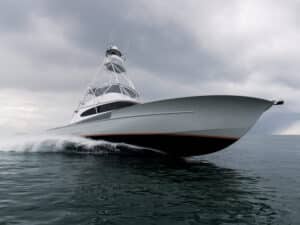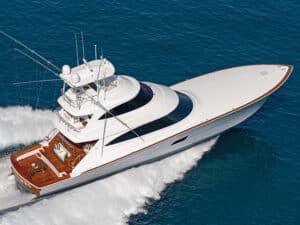By now, you all know the story behind the name. Old man Cavileer built boats back in the Revolutionary War days. History buffs claim he built the boats that Washington used to cross the Delaware. Now, old man Cavileer is buried somewhere on the Cavileer property, watching over things as John DiDonato builds boats. Since the company continues to consistently put out high-quality product, I guess the old man rests in peace.
Some of you may be questioning our sanity right about now, shouting with smug superiority, “The Cavileer 53 isn’t new!” But DiDonato felt that the previous 53 had enough room for improvement that he redesigned the entire boat from top to bottom with the help of the unmatched design skills of Donald Blount. Certainly, with Blount’s help the 53 spins up to a higher speed. Other significant differences from the old 53 include a complete redesign of all systems locations for an improved center of gravity. This entailed moving the generator, engines, fuel tankage, batteries and even the pumps. They’ve all been relocated to generate a more efficient running angle.
Topping it off, the 53 boasts an all-new flybridge with a different console and seating arrangement. Inside, all bulkheads, storage compartments and trim tabs have been replaced. This is indeed a brand-new Cavileer 53.
Performance
Cavileer installed new Series 60 Detroit/MTU diesels rated at 825 hp each. While testing the new 53 out of Miami’s Government Cut, the MTUs generated a top speed of 34.6 knots at 2,350 rpm. While that may represent the middle of the road in speed on today’s market, it keeps the most egregious fuel consumption to just 76 gph total — well below the 100-plus gallons many other 50-footers gulp when going faster. Cruising at 29 knots, the 53 burns just 48 gph.
I loved the boat’s responsiveness in a hard turn: The 53 reversed course at cruising speed in about three boat lengths. Tournament fishing requires agility, and the Cavileer excels there as well. It backs down at about 5 knots without taking much water into the cockpit. In fact, the only water that comes in does so through the hawseholes; the tuna door seemed watertight. You’d really have to push the transom back hard to get water up high enough to come inside.
Drifting abeam of the seas, the 53 exhibited a short roll moment with very gentle transitions. In other words, it rolls quickly but not very far.
**Cockpit
**Cavileer’s cockpit consists of all the standard fare, including a forward-end tackle/rigging station, centerline engine compartment access and freezer/drink locker modules. You’ll find empty space rather than compartments or storage under the gunwales. Lift-out fish boxes with macerators hide under the cockpit sole, and a livewell in the transom doubles as a smaller fish box when you aren’t live-baiting.
Gunwales meet an angler at midthigh, and though it’s a stretch to reach the water’s surface to release a fish, gaffing poses no problem. Cavileer provides average rod storage around the cockpit, too, with six rocket launchers across the back of the flybridge rail and four in-gunwale rod holders.
**Interior
**Though a fairly traditional salon, the Cavileer’s living room seemed particularly spacious, thanks to the more open layout. A large L-shaped settee to starboard faces the entertainment center and the aft end of the larger-than-average dinette. The galley to starboard’s low counter adds to the feeling of a much larger space.
Belowdecks, a crew’s cabin to port with over/under single berths shares a head and shower with the island-berth guest stateroom in the forepeak. The master cabin and private head to starboard situate the queen-sized berth with the head of the bed aft.
**Flybridge
**This has to be one of the largest flybridges on any 53-footer I’ve ever seen. The centerline helm leaves miles of space for the wraparound forward seating. The bigger a flybridge gets, the more difficult it becomes to provide the helmsman with an unobstructed view of the foredeck and the cockpit. One concession to having a helm far enough aft to see the fighting chair in the cockpit is less visibility forward. Cavileer resolved this dilemma by engineering a scalloped section on centerline in the brow to abet the helmsman’s view of the foredeck. I particularly appreciate how much room Cavileer provides behind the helm and companion seats for passage, too. I hate trying to squeeze by the helmsman or asking him to move.
Of course, all the seating and the helm console provide storage underneath as well. And to save steps, you can keep the deep, refrigerated drink cooler stocked with beverages so your guests rarely have to leave the bridge.
**Engine Room
**I’ve been on much larger boats that didn’t offer nearly as much work space as the Cavileer 53. Even I — with my considerable girth — can climb around outboard of the engines with little effort. Not that you’d necessarily have to, as all surfaces are nonporous and high-gloss for easy cleaning, and all routine maintenance points have been located on centerline. I might even qualify this space as downright stark in its cleanliness.
All in all, Cavileer builds a solid, handsome sportfishing boat — a boat anyone could rightfully be proud of. But it’s a boat that’s hard to buttonhole as to exactly where it fits in the industry. DiDonato has an answer.
“We look at some of the benchmark boatbuilders in the custom business ? companies like Hines-Farley, for example ? and we try to come as close as we can to matching the quality and finish of those boats at a price point somewhere between the production and custom builders.”
That works for me — and obviously for a lot of offshore fishermen, too.







